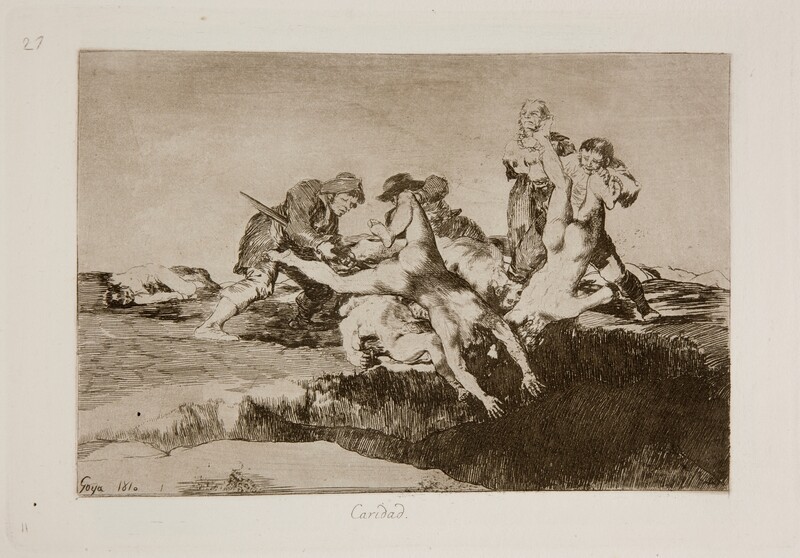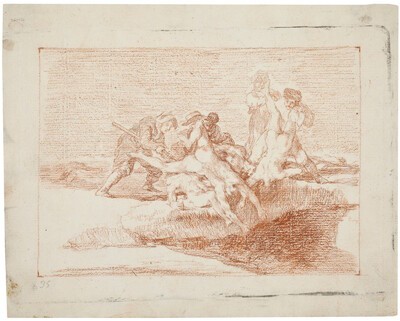- Cronología
- 1810
- Dimensiones
- 163 x 236 mm
- Técnica y soporte
- Etching, aquatint, burin, drypoint and burnisher
- Reconocimiento de la autoría de Goya
- Undisputed work
- Ficha: realización/revisión
- 02 Dec 2010 / 07 Nov 2024
- Inventario
- 225
Goya (lower left-hand corner), 11 (lower left-hand corner)
See Sad presentiments of what must come to pass.
In the artist's proofs we can see a gradual softening in the definition of the muscles of the corpses being thrown into the mass grave.
The title was handwritten on the print by Goya in the first and only series that is known to have been printed at the time the works were created, which the artist gave to his friend Agustín Ceán Bermúdez. Therefore, the title was etched into the plate at a later date and left unchanged as of the first edition of the Disasters of War printed by the San Fernando Royal Academy of Fine Arts in Madrid in 1863, after the printing of the series in the possession of Ceán Bermúdez.
There is a surviving preparatory drawing for this print which is housed in the Prado Museum in Madrid.
In order to avoid the spread of diseases in times of war, corpses were buried in mass graves. This is exactly what Goya shows in this print, in which we can see various men throwing decapitated, totally naked bodies into a grave. On the edge of the pit other naked corpses are piled up, ready to be thrown into the grave.
The title of the print is loaded with a strong sense of irony, since there is little charity in this gesture: on the contrary, it is an act of selfishness, as was the concern to attend to the wounded in order to ensure that they could later go forth into battle once more.
In the background we can see a standing figure who stares into space with a preoccupied expression. This might be a self-portrait of Goya himself witnessing the scene. It is likely that the artist would have seen some scenes of this kind in person and that he would have made studies in the moment of the action. However, the dominant trend in this series of avoiding characterizing figures or giving specific geographical references suggests that the majority of the images in The Disasters of War were the fruit of a mental process of composition based on events that the artist had seen.
The plate is stored in the National Chalcography (cat. 278).
-
Goya and his timesThe Royal Academy of ArtsLondon1963cat. 66cat. 241
-
De grafiek van GoyaRijksmuseum RijksprentenkabinetAmsterdam1970from November 13th 1970 to January 17th 1971cat. 71
-
Goya. Das Zeitalter der Revolucionen. Kunst um 1800 (1980 – 1981)Hamburger KunsthalleHamburg1980cat. 79
-
Francisco de GoyaMuseo d'Arte ModernaLugano1996exhibition celebrated from September 22nd to November 17th.cat. 26
-
Francisco Goya. Sein leben im spiegel der graphik. Fuendetodos 1746-1828 Bordeaux. 1746-1996Galerie KornfeldBern1996from November 21st 1996 to January 1997cat. 115
-
Francisco Goya. Capricci, follie e disastri della guerraSan Donato Milanese2000Opere grafiche della Fondazione Antonio Mazzottacat. 107
-
Goya. Opera graficaPinacoteca del Castello di San GiorgioLegnano2006exhibition celebrated from December 16th 2006 to April 1st 2007p. 64
-
Goya en tiempos de guerraMuseo Nacional del PradoMadrid2008consultant editor Manuela B. Mena Marqués, from April 14th to July 13th 2008cat. 105
-
Goya et la modernitéPinacothèque de ParisParís2013from October 11st 2013 to March 16th 2014cat.66
-
Goya: Order and disorderMuseum of Fine ArtsBoston2014cat. 1
-
Goya, grabadorMadridBlass S.A.1918cat. 129
-
Goya engravings and lithographs, vol. I y II.OxfordBruno Cassirer1964cat. 147
-
Vie et ouvre de Francisco de GoyaParísOffice du livre1970cat. 1038
-
Catálogo de las estampas de Goya en la Biblioteca NacionalMadridMinisterio de Educación y Cultura, Biblioteca Nacional1996cat. 229
-
El Libro de los Desastres de la GuerraMadridMuseo del Prado2000pp. 55-57
-
ParísPinacoteca de París2013p. 133
-
Goya: Order & DisorderBostonMuseum of Fine Arts Boston Publications2014p. 12
-
Goya. In the Norton Simon MuseumPasadenaNorton Simon Museum2016pp. 114-151

